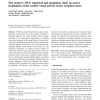Free Online Productivity Tools
i2Speak
i2Symbol
i2OCR
iTex2Img
iWeb2Print
iWeb2Shot
i2Type
iPdf2Split
iPdf2Merge
i2Bopomofo
i2Arabic
i2Style
i2Image
i2PDF
iLatex2Rtf
Sci2ools
MBEC
2011
2011
Size matters: MEG empirical and simulation study on source localization of the earliest visual activity in the occipital cortex
Abstract While the relationship between sensory stimulation and tasks and the size of the cortical activations is generally unknown, the visual modality offers a unique possibility of an experimental manipulation of stimulus size-related increases of the spatial extent of cortical activation even during the earliest activity in the retinotopically organized primary visual cortex. We used magnetoecephalography (MEG), visual stimuli of increasing size, and numerical simulations on realistic cortical surfaces to explore the effects of increasing spatial extent of the activated cortical sources on the neuromagnetic fields, location estimation biases, and source resolution. Source localization was performed assuming multiple dipoles in a sphere model using an efficient, automatically restarted multi-start simplex minimizer within the Calibrated Start SpatioTemporal (CSST) algorithm. We found size-related effects on amplitude and latencies and differences in relative locations of the earli...
| Added | 16 Sep 2011 |
| Updated | 16 Sep 2011 |
| Type | Journal |
| Year | 2011 |
| Where | MBEC |
| Authors | Sanja Josef Golubic, Ana Susac, Veljko Grilj, Douglas Ranken, Ralph Huonker, Jens Haueisen, Selma Supek |
Comments (0)

